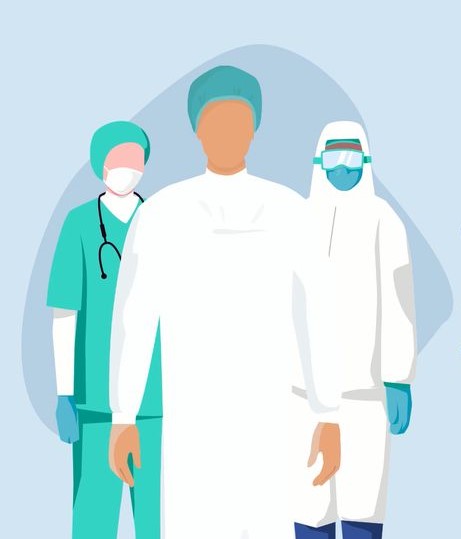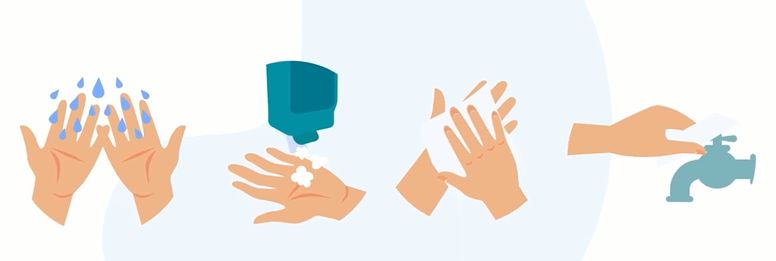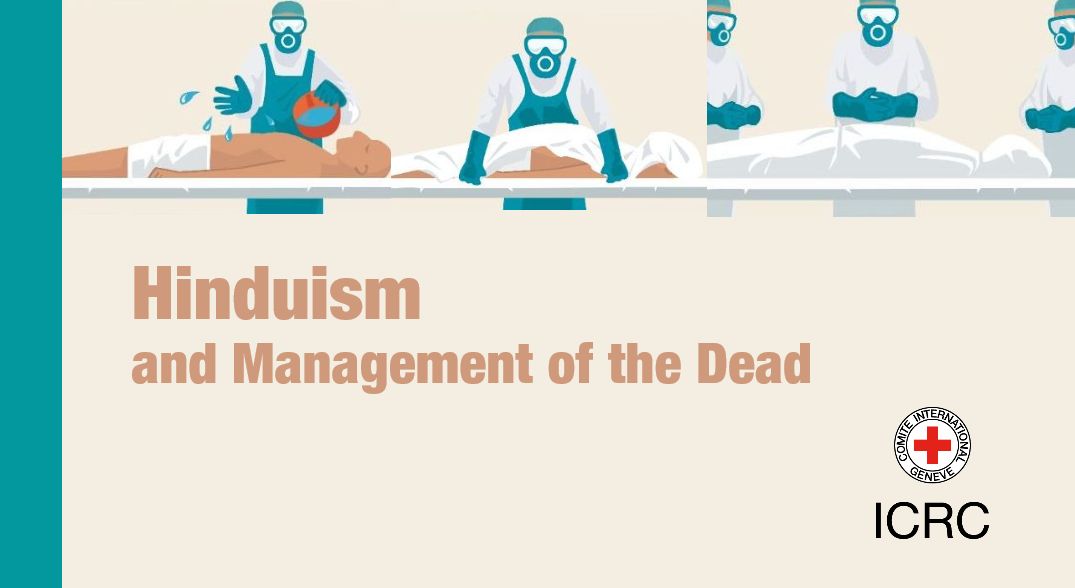The outbreak of the COVID-19 pandemic has meant that last rites have to be accelerated and adapted to minimise the number of people involved, and close contact with the dead body is not possible without personal protective equipment (PPE). This makes it challenging for family and friends of the deceased to cope with their loss.
Lack of familiarity with cultural and religious practices on the part of personnel involved in dead body management can have serious consequences for the society. This article will aid in understanding the Hindu perspective on management of the dead, and how last rites might be adapted to minimise the possible risk of further infection in relation to the COVID-19 pandemic.
Hinduism
Hinduism is one of the oldest religions in the world, and the third largest after Christianity and Islam, with adherents numbering around 1.15 billion or 15–16% of the world population. Outside its Indian heartland, Hinduism is the majority religion in Nepal, Mauritius and the Indonesian island of Bali, while Hindus form significant minorities in Bangladesh, Sri Lanka, Pakistan, Bhutan, Malaysia and Singapore, and are otherwise spread in a sizeable diaspora across Asia, Europe, North America, the Caribbean and Africa.[1]
Hindu beliefs are highly diverse. Rather than one creed or unified system, Hinduism encompasses a vast diversity of religious beliefs and phenomena, encapsulated in scriptures ranging from the earliest Vedas through to the Upanishads, Puranas and epics such as the Mahabharata, Bhagavad Gita and Ramayana. Most Hindus believe that all living creatures have an Atman — variously a soul, self, spirit or essence — which is either one with or distinct from Brahman, variously the supreme soul, essence or first principle of all creation, depending on the school of thought. Though the mind and body are subject to death, the Atman is indestructible and eternal, passing between different beings through reincarnation over many lifetimes.[2]
Management of the Dead in Hinduism
The funeral or Antyesti (literally ‘last sacrifice’) is the last Samskara (rite of passage) in the Hindu life cycle. It is traditionally arranged as soon as possible, usually within 24 hours of death, though exceptions may be made given the circumstances of the death or the needs of the family.[3]
In Hinduism, there are mainly three types of funerals: Agni Dah (cremation), Bhu Samadhi (burial), and Jal Samadhi (water burial). Most Hindus cremate their dead, but Sadhus (Hindu saints) and infants are traditionally buried or immersed in the river.
Autopsy, embalming and organ donation are acceptable for Hindus, and there are no specific rules for performing autopsies in Hinduism.
The details of funeral rites vary considerably depending on the school of thought, community, caste, gender and age of the dead, and only a very generalised description can therefore be presented here.
The body is washed by family members, and sometimes close friends. If this is not possible, others may also do so. The body is then dressed in simple clothing and adorned with marks of the family and community. Since the dead body is regarded as impure, extreme care is taken by all mourners to otherwise avoid unnecessary touching of the body, which is considered an act of disrespect.[4]
At the funeral ceremony itself, the body is covered with flowers, a lamp lit near the head, incense burnt, and water sprinkled on the body during the ceremony. The body is carried on a bamboo stretcher or by vehicle to the place of cremation, whether an open-air cremation ground (traditionally on the banks of a sacred river), crematorium or funeral home. Those who attend the cremation, and are therefore exposed to the dead body or cremation smoke, wash as soon as possible after the cremation, since the cremation ritual is considered unclean and polluting.
On the third day after the cremation, the ashes of the deceased are collected and scattered in a river, the sea or another place of importance for the deceased or their family.
Impact of COVID-19
 While Hindu last rites are therefore flexible and already well adapted to minimising contact with the dead body, the Government of India has published the following guidelines related to the final rites of those who are confirmed or believed to have died due to COVID-19[5]:
While Hindu last rites are therefore flexible and already well adapted to minimising contact with the dead body, the Government of India has published the following guidelines related to the final rites of those who are confirmed or believed to have died due to COVID-19[5]:
- Crematorium staff should be sensitised to the possible risk of infection and provided with PPE.
- Staff must practice standard precautions of hand hygiene, use of masks and gloves.
- Viewing of the dead body by unzipping the face-end of the body bag (by staff using standard precautions) may be allowed so that relatives can see the deceased for one last time.
- Rituals such as reading from religious scriptures, sprinkling holy water and any other last rites that do not require touching the body may be allowed.
- Bathing, kissing, hugging etc. of the dead body should not be allowed.
- The funeral staff and family members of the deceased should wash their hands thoroughly after performing the last rites.
- The ashes of the deceased do not pose any risk and may be collected to perform the last rites.
- Large gatherings at the crematoriums should be avoided as a social distancing measure as it is possible that close family contacts may be infected with the virus.
Autopsy has also been debated widely in relation to COVID-19 in India. The central government has advised against conducting autopsies of confirmed COVID-19 patients. For suspected cases, the decision-making power remains with states and hospitals depending on the availability of testing kits.
ICRC Guidance
The ICRC guidance on management of the dead due to COVID-19 also aims to protect the lives of healthcare workers, body handlers and the rest of the community.[6] With proper preparation and planning, the safety of healthcare workers on the frontline of the response can be ensured, as well as the dignity of those who are confirmed/believed to have died due to COVID-19.
- Apart from physical distancing and avoiding contact, the ICRC advocates caution with respect to the handling of COVID-19 dead bodies, since it remains unclear for how long the risk of infection from the dead body or bodily fluids persists.
- If the family members wish to see the body, they should use PPE to do so before the body is bagged.
- PPE must be used by those handling the dead. The body of a deceased person must be completely wrapped in a leakage proof body bag (or double-bagged) before being moved to the mortuary.
- The body bag(s) should not be opened again prior to cremation.
- Bodies should not be embalmed or injected with preservatives. The process of embalming can result in the unnecessary manipulation of the body that may expel fluid from the body’s cavity and/or result in aerosolisation leading to an increased risk for those performing such procedure.
- Non-essential complete autopsies need not be performed.
 Every effort should be made to ensure reliable documentation, identification and traceability of the dead so as to avoid misidentification and trauma for loved ones.
Every effort should be made to ensure reliable documentation, identification and traceability of the dead so as to avoid misidentification and trauma for loved ones.- While dead body management and funeral rites should be adapted to maintain social and physical distancing, hasty and careless disposal of the bodies must be avoided.
- Irrespective of whether the body is infectious or not, there is a chance that family members of the deceased are infected. Gatherings at home, hospitals, mortuary and funerals are highly inadvisable regardless of how the dead body is handled and have sometimes been banned.
- Those who attend the funeral must safely dispose of the PPE and properly practice hand hygiene by washing themselves with soap, water or alcohol-based sanitiser.

[1] https://en.wikipedia.org/wiki/Hinduism
[2] Ibid.
[3] Ibid. https://www.everplans.com/articles/hindu-funeral-traditions
[4] Susan Thrane; Hindu End of Life: Death, Dying, Suffering, and Karma Journal of Hospice and Palliative Nursing 12(6):337-342; https://www.crossroadshospice.com/hospice-palliative-care-blog/2015/december/30/the-culture-connection-hindu-end-of-life-practices-healthcare-professionals-blog/
[5] COVID-19: Guidelines on dead body management, Government of India Ministry of Health & Family Welfare Directorate General of Health Services (EMR Division) dated 15.03.2020.
[6] ICRC COVID-19: General guidance for management of the dead; https://www.icrc.org/en/document/protection-dignity-and-respect-deceased-individuals-and-their-families-covid-19






